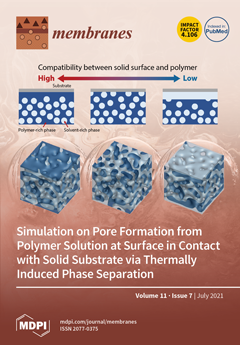Ammonia losses from manure pose serious problems for ecosystems and human and animal health. Gas-permeable membranes (GPMs) constitute a promising approach to address the challenge of reducing farm ammonia emissions and to attain the EU’s Clean Air Package goals. In this study, the effect of NH
3-N concentration, membrane surface area, acid flux, and type of capture solution on ammonia recovery was investigated for a suspended GPM system through three experiments, in which ammonia was released from a synthetic solution (NH
4Cl + NaHCO
3 + allylthiourea). The effect of two surface areas (81.7 and 163.4 cm
2) was first evaluated using three different synthetic N emitting concentrations (3000, 6000, and 12,000 mg NH
3-N∙L
−1) and keeping the flow of acidic solution (1N H
2SO
4) constant (0.8 L·h
−1). A direct relationship was found between the amount of NH
3 captured and the NH
3-N concentration in the N-emitting solution, and between the amount of NH
3 captured and the membrane surface area at the two lowest concentrations. Nonetheless, the use of a larger membrane surface barely improved ammonia capture at the highest concentration, pointing to the existence of other limiting factors. Hence, ammonia capture was then studied using different acid flow rates (0.8, 1.3, 1.6, and 2.1 L∙h
−1) at a fixed N emitting concentration of 6000 mg NH
3-N∙L
−1 and a surface area of 122.5 cm
2. A higher acid flow rate (0.8–2.1 L∙h
−1) resulted in a substantial increase in ammonia absorption, from 165 to 262 mg of NH
3∙d
−1 over a 14-day period. Taking the parameters that led to the best results in experiments 1 and 2, different types of ammonia capture solutions (H
2SO
4, water and carbonated water) were finally compared under refrigeration conditions (at 2 °C). A high NH
3 recovery (81% in 7 days), comparable to that obtained with the H
2SO
4 solution (88%), was attained when chilled water was used as the capture solution. The presented results point to the need to carefully optimize the emitter concentration, flow rate, and type of capture solution to maximize the effectiveness of suspended GPM systems, and suggest that chilled water may be used as an alternative to conventional acidic solutions, with associated savings.
Full article






